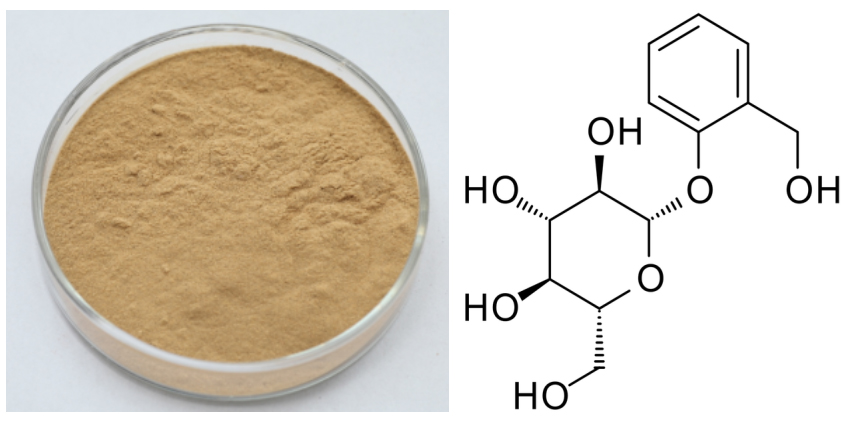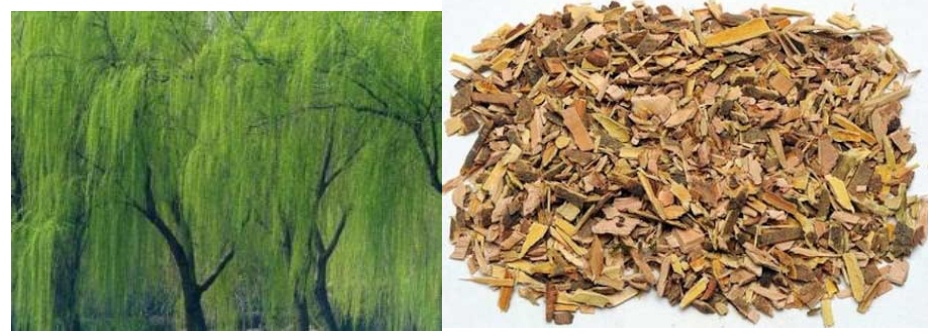Renewable Design for White Willow Bark Extract Factory for Libya
Renewable Design for White Willow Bark Extract Factory for Libya Detail:
[Latin Name] Salix alba L.
[Plant Source] from China
[Specifications] Salicin 15-98%
[Appearance] Yellow Brown to White powder
Plant Part Used: Bark
[Particle size] 80 Mesh
[Loss on drying] ≤5.0%
[Heavy Metal] ≤10PPM
[Storage] Store in cool & dry area, keep away from the direct light and heat.
[Shelf life] 24 Months
[Package] Packed in paper-drums and two plastic-bags inside.
[Net weight] 25kgs/drum
Brief Introduction
Salicin is a naturally occurring compound found in the bark of several species of trees, primarily North American in origin, that are from the willow, poplar, and aspen families. White willow, from whose Latin name, Salix alba, the term salicin is derived, is the most well known source of this compound, but it is found in a number of other trees, shrubs, and herbaceous plants as well being synthesized commercially. It is a member of the glucoside family of chemicals and is used as an analgesic and antipyretic. Salicin is used as a precursor for the synthesis of salicylic acid and acetylsalicylic acid, commonly known as aspirin.
A colorless, crystalline solid in its pure form, salicin has the chemical formula C13H18O7. Part of its chemical structure is equivalent to the sugar glucose, meaning it is classified as a glucoside. It is soluble, but not strongly so, in water and alcolhol. Salicin has a bitter taste and is a natural analgesic and antipyretic, or fever reducer. In large quantities, it can be toxic, and overdoses may lead to liver and kidney damage. In its raw form, it may be mildly irritating to skin, respiratory organs, and eyes.
Function
1. Salicin is used to ease pain and reduce inflammation.
2. Relieve acute and chronic pain, including headache, back and neck pain, muscle aches, and menstrual cramps; Control arthritis discomforts.
3. Relieve acute and chronic pain.
4. It has the same effect on the body as aspirin without any of the side effects.
5. It is an anti-inflammatory, a fever reducer, an analgesic, an anti-rheumatic, and an astringent. Specifically, it helps to relieve headaches.
Application
1.Anti-inflammatory, anti-rheumatic,
2.Reduce a fever,
3.Use as an analgesic and astringent,
4.Relieve headache,
5.Ease pain caused by rheumatism, arthritis, and carpal tunnel syndrome.
Product detail pictures:

Related Product Guide:
Our solutions are broadly acknowledged and dependable by users and may meet consistently developing economic and social requires for Renewable Design for White Willow Bark Extract Factory for Libya , The product will supply to all over the world, such as: Greece, Slovak Republic, America, As an experienced group we also accept customized order and make it same as your picture or sample specifying specification and customer design packing. The main goal of our company is to build up a satisfactory memory to all customers, and establish a long term win-win business relationship. Choose us, we always wait for your appearance!
A recitation of the poem by Eve Merriam
(3 Nov 2009) SHOTLIST
DPRK, Kaesong, 28th August 2009
1. Pan of Kaesong City
2. Wide shot of modern buildings in Kaesong City
3. Pan of historic area of Kaesong City
4. Various shots of historic houses and people in streets
5. Pan of ginseng field
6. Pan of ginseng plants
7. Tilt up of ginseng plant
8. Wide shot of worker walking down row of ginseng plants
9. Close up of worker’s hands uprooting ginseng and holding it up
10. Close up and zoom in of entire five-year old ginseng root
11. SOUNDBITE (Korean) Ri Taek Gyu, leader of Sonjok area work team, Insam Cooperative Farm, Kaesong City:
“This is the real ginseng, this is five years old. The flowers are in full bloom in July and now we’re coming to harvest time.”
12. Wide shot of Koryo Songgyungwan University
13. Close up of University sign on stone
14. SOUNDBITE (Korean) Chang Jae Suk, Associate Professor, Koryo Insam Faculty, Koryo Songgyungwan University:
“The cultivation of ginseng began in Kaesong in the 11th century. Kaesong is the first place where the cultivation and processing methods developed. Cultivation and processing techniques for ginseng were developed for the first time in Kaesong.”
15. Tilt up of sample of ginseng in jar of alcohol
16. SOUNDBITE (Korean) Chang Jae Suk, Associate Professor, Koryo Insam Faculty, Koryo Songgyungwan University:
“There are many countries in the world that cultivate ginseng, but the reason why Kaesong ginseng is particularly good is because of the special character of the soil in the area. Many special elements such as radium and germanium and selenium are present in the soil of the Kaesong area. These elements are absorbed into the ginseng, and that’s where ginseng gets its special medicinal effects from.”
AP Television
DPRK, Pyongyang, 30th August 2009
17. Wide shot of Academy of Koryo Medical Science
18. Mid shot of sign of Academy of Koryo Medical Science
19. SOUNDBITE (Korean) Ko Myong Jin, Associate Professor, Vice President of Academy of Koryo Medical Science:
“Kaesong ginseng is widely used as a tonic because it is more efficacious than the ginseng from other countries, and also it has no side effects. In particular, it has a very good pharmaceutical efficacy, it has anti-cancer properties, it is very good at preventing harm from exposure to radiation, and also preventing the symptoms of the onset of age. Recently, Kaesong ginseng is becoming widely known around the world because it’s good for the treatment of diabetes.”
AP Television
DPRK, Kaesong, August 29, 2009
20. Wide shot of exterior of shop selling ginseng
21. Mid shot of sign of shop
22. Wide shot inside shop with customers
23. Mid shot of sales assistants and customers at counter
24. Close up of dried ginseng root tilt up to wide of customers at counter
25. SOUNDBITE (Korean) Yun Gum Chun, sales assistant, Ginseng shop:
“There’s a great demand for ginseng products. Not only our people, but also Koreans abroad, and foreigners like the products, and buy a lot.”
26. Close up of ginseng
27. Wide shot of various ginseng products on shop shelves
28. Close up of “Insam Woman Tonic” on shelf
29. Pan of sales assistant and customers
LEADIN:
Ginseng is well known around the world as a health supplement.
But not many people know that it’s also one of the products North Korea is proud of.
STORYLINE:
Kaesong is a city which found itself on the northern side of the dividing line between the two Koreas, following one of the fiercest confrontations of the Cold War.
From 1950 to 1953, Korea’s civil war drew in the US, and United Nations’ forces on one side, and China on the other.
North Korean experts say that the root of the ginseng plant is prized for a multitude of health-giving properties.
You can license this story through AP Archive: https://www.aparchive.com/metadata/youtube/b6178becb7a77cd5258632e390a6de58
Find out more about AP Archive: https://www.aparchive.com/HowWeWork
We are a small company that has just started, but we get the company leader's attention and gave us a lot of help. Hope we can make progress together!






